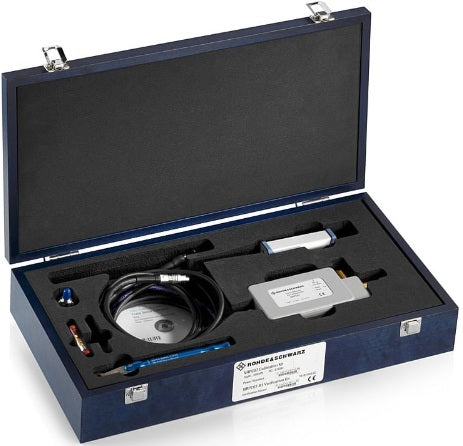

The five modular R&S NRPC calibration kits are used to calibrate R&S NRP power sensors, as well as other makes, to a very high level of accuracy. Following calibration, the sensors are within the specified calibration uncertainties and usually remain below these uncertainties. Each calibration kit includes a highly accurate power standard that is traceable to primary power standards of the Physikalisch-Technische Bundesanstalt (PTB, Germany's National Metrology Institute) by means of a calibration accredited by the Deutsche Akkreditierungsstelle (DAkkS, Germany's National Accreditation Body).
In combination with a remotely controllable microwave generator, an R&S NRX power meter and the free-of-charge R&S Recal+ PC software, the calibration kits enable users to calibrate the power sensors of the R&S NRP and R&S FSH family in just a few minutes. Calibration also includes writing the updated calibration values to the sensor's data memory. Plug-ins for the R&S ZVA and R&S ZNB vector network analyzers are available for impedance calibration. The calibration uncertainty is determined individually for each power sensor, taking the relevant influence quantities into account.
The additional R&S NRPC-LS linearity standard complements the calibration setup. It enables remote linearity calibration of the R&S NRP power sensors.
The R&S NRPCxx-B1 option is used for regular verification of each R&S NRPC model. It consists of a thermal power sensor calibrated to the associated power standard and aligned such that it displays, for each frequency point, the same value as the power standard.
Calibration is a matter of trust, especially when using power meters, which are at the top of the calibration hierarchy, for high-frequency test and communications equipment. Rohde & Schwarz and its solid, innovative products have played a key role in shaping this market segment for many years. The company's location in Germany, its experienced development and production experts, and high manufacturing depth ensure that more and more users involved in R&D, production and service worldwide rely on power sensors from Rohde & Schwarz. The technologies developed for these sensors are also used in the R&S NRPC calibration kits' power standards.
Especially when extremely high measurement accuracy is required, as is normally the case for power standards, a sensor type based on the antiquated thermistor technology is still being used today. The big advantage of inherent stability is offset by significant limitations that make it extremely difficult to work with these sensors. These limitations include poor impedance matching, long settling times in the seconds range, and a small dynamic range.
The thermal sensors used in the R&S NRPC calibration kits' power standards provide more accurate measurements and, at the same time, higher measurement speed, eliminating the disadvantages mentioned above. In addition, the new sensors feature the same high stability provided by thermistor based sensors but are easier to verify, which is a further advantage. The key lies in the frequency range (down to DC) of the thermoelectric transducers used, an exclusive characteristic of all Rohde & Schwarz thermal power sensors. Furthermore, the R&S NRPC calibration kits provide quick verification at any time: A DC reference circuit has been integrated into the power standard. This allows a fully automatic test to be performed in just a few seconds.
*The image is for reference only. See product specification for details.
Model No
NRPC40
Condition
New
Manufacturer
Rohde & Schwarz
Hey👋Let's start with your email